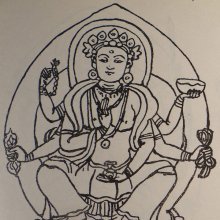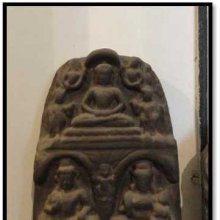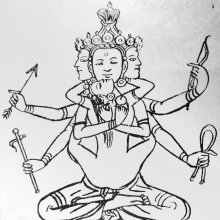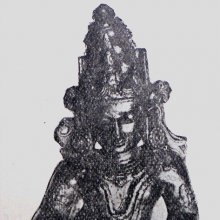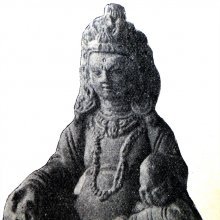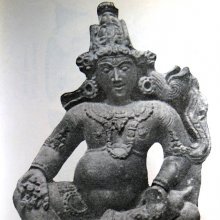Lotus seat, Lotus pose: 2 definitions
Introduction:
Lotus seat means something in Hinduism, Sanskrit. If you want to know the exact meaning, history, etymology or English translation of this term then check out the descriptions on this page. Add your comment or reference to a book if you want to contribute to this summary article.
Images (photo gallery)
In Hinduism
Shilpashastra (iconography)
Source: Shodhganga: Elements of Art and Architecture in the Trtiyakhanda of the Visnudharmottarapurana (shilpa)The Lotus Seat is associated with various deities, whose iconography is described in the Viṣṇudharmottarapurāṇa, an ancient Sanskrit text which (being encyclopedic in nature) deals with a variety of cultural topics such as arts, architecture, music, grammar and astronomy.—In the Viṣṇudharmottarapurāṇa, the attire, accessories, weapons, carrier, different colours etc. of the idols of different deities are projected which are taken for discussion here. It is clear that the book offers a great field of knowledge regarding the nuances of Indian art of Image making [e.g., lotus seat] during 10th–11th century A.D.
The Lotus Seat of Brahmā.—The image of Brahmā should have four faces and four arms. But in the Vāyupurāṇa, Brahmā is known for fourteen faces. According to the Viṣṇudharmottarapurāṇa, the image of Brahmā should be made in the posture of being seated on a lotus seat. This book states that the dress of Brahmā should be the skin of an antelope.
The Lotus Seat of Agni.—According to the Viṣṇudharmottarapurāṇa, the image of Agni should be placed on a chariot adorned with the images of four parrots and a symbol of smoke. But in the Śilparatna, the image of Agni is instructed to be placed on the seat of a lotus.

Shilpashastra (शिल्पशास्त्र, śilpaśāstra) represents the ancient Indian science (shastra) of creative arts (shilpa) such as sculpture, iconography and painting. Closely related to Vastushastra (architecture), they often share the same literature.
Yoga (school of philosophy)
Source: ORA: Amanaska (king of all yogas): A Critical Edition and Annotated Translation by Jason BirchThe Lotus Pose is known in the Sanskrit language as Padmāsana, according to the Dattātreyayogaśāstra verse 35-38ab.—Accordingly, while describing the lotus pose (padmāsana): “Having carefully placed the upturned feet on the thighs and the upturned hands in between the thighs, [the Yogin] should fix the eyes on the tip of the nose. Having lifted the uvula with the tongue; having fixed the chin on the chest and having drawn in the breath slowly according to his capacity, he should fill [the region of] the stomach. After that, he should exhale the breath slowly according to his capacity. This is said to be padmāsana, which destroys all diseases”.

Yoga is originally considered a branch of Hindu philosophy (astika), but both ancient and modern Yoga combine the physical, mental and spiritual. Yoga teaches various physical techniques also known as āsanas (postures), used for various purposes (eg., meditation, contemplation, relaxation).
See also (Relevant definitions)
Partial matches: Lotus, Pose, Seat, A.
Full-text (+128): Padmasana, Foot, Thigh, Amburutpitha, Pushkaravishtara, Abjapitha, Kavikamalasadman, Chin, Uvula, Disease, Asana, Svargasana, Ekacakra, Stomach, Baddhapadmasana, Slowly, Sarvvanga, Sadhakottama, Paramashakti, Lakshmi.
Relevant text
Search found 46 books and stories containing Lotus seat, Lotus pose, Seat of a lotus; (plurals include: Lotus seats, Lotus poses, Seat of a lotuses). You can also click to the full overview containing English textual excerpts. Below are direct links for the most relevant articles:
Jain Remains of Ancient Bengal (by Shubha Majumder)
Caubisi type of Pārśvanātha Sculptures < [Chapter 6 - Iconographic Study of Jaina Sculptural Remains]
Planetary Deities type of Ṛṣabhanātha Sculptures < [Chapter 6 - Iconographic Study of Jaina Sculptural Remains]
Sripura (Archaeological Survey) (by Bikash Chandra Pradhan)
Gandhesvara Temple < [Chapter 2 - The Architectural Panorama]
Scultures of Ratnapani < [Chapter 3 - Sculptural Programme]
Bhakti-rasamrta-sindhu (by Śrīla Rūpa Gosvāmī)
Verse 4.2.10 < [Part 2 - Astonishment (adbhuta-rasa)]
Guhyagarbha Tantra (with Commentary) (by Gyurme Dorje)
Text 9.6 (Commentary) < [Chapter 9 (Text And Commentary)]
Text 6.5 (Commentary) < [Chapter 6 (text and commentary)]
Text 12.13 (Commentary) < [Chapter 12 (Text and Commentary)]
Tiruvaymoli (Thiruvaimozhi): English translation (by S. Satyamurthi Ayyangar)
Pasuram 3.1.1 < [Section 1 - First Tiruvaymoli (Mutic coti)]
Pasuram 6.10.10 < [Section 10 - Tenth Tiruvaymoli (Ulakam unta Peruvaya)]
Introduction to Section 3.1 < [Section 1 - First Tiruvaymoli (Mutic coti)]
The Garuda Purana (by Manmatha Nath Dutt)
Chapter XXIV - The worship of Ganapati < [Agastya Samhita]
